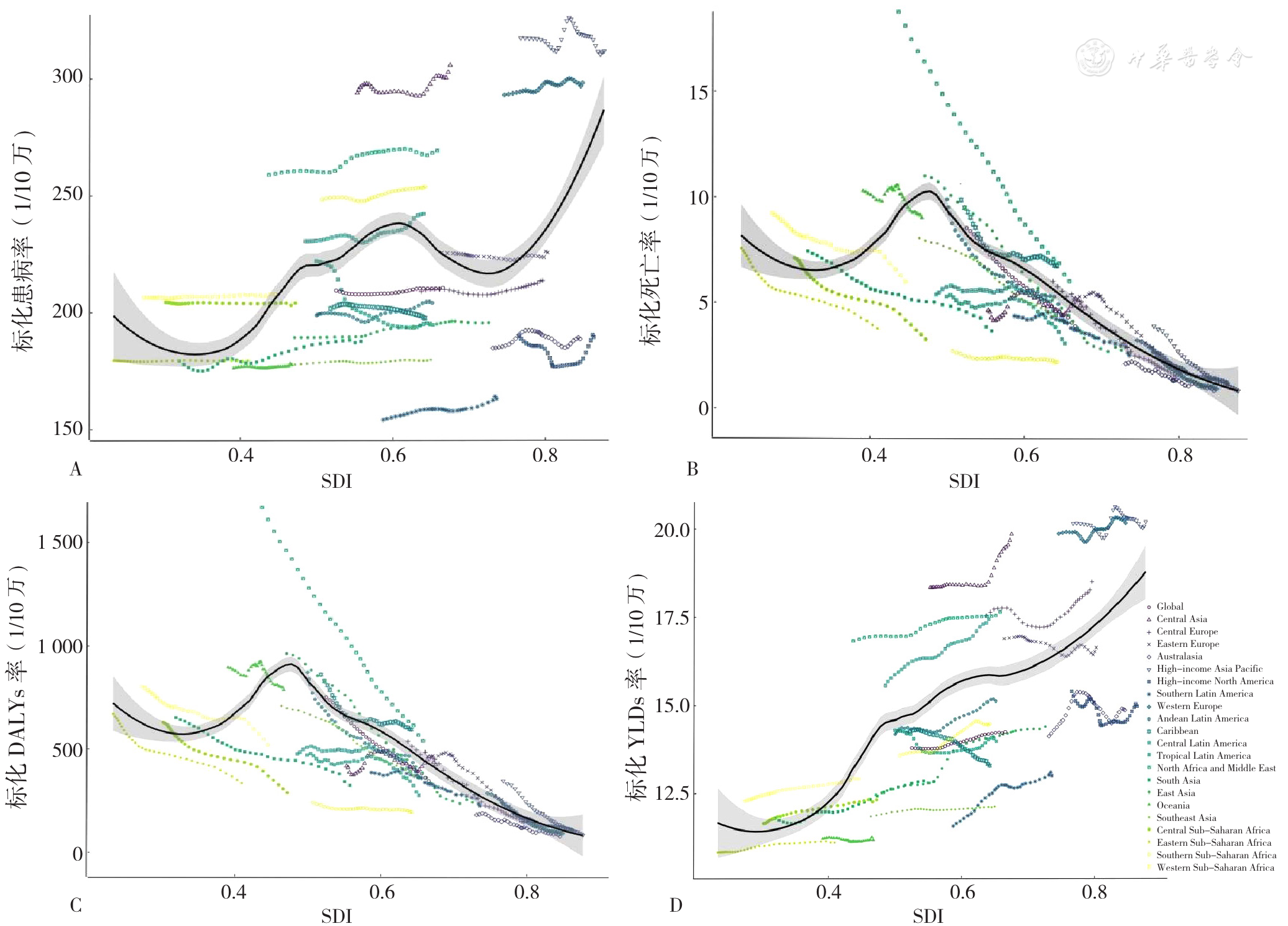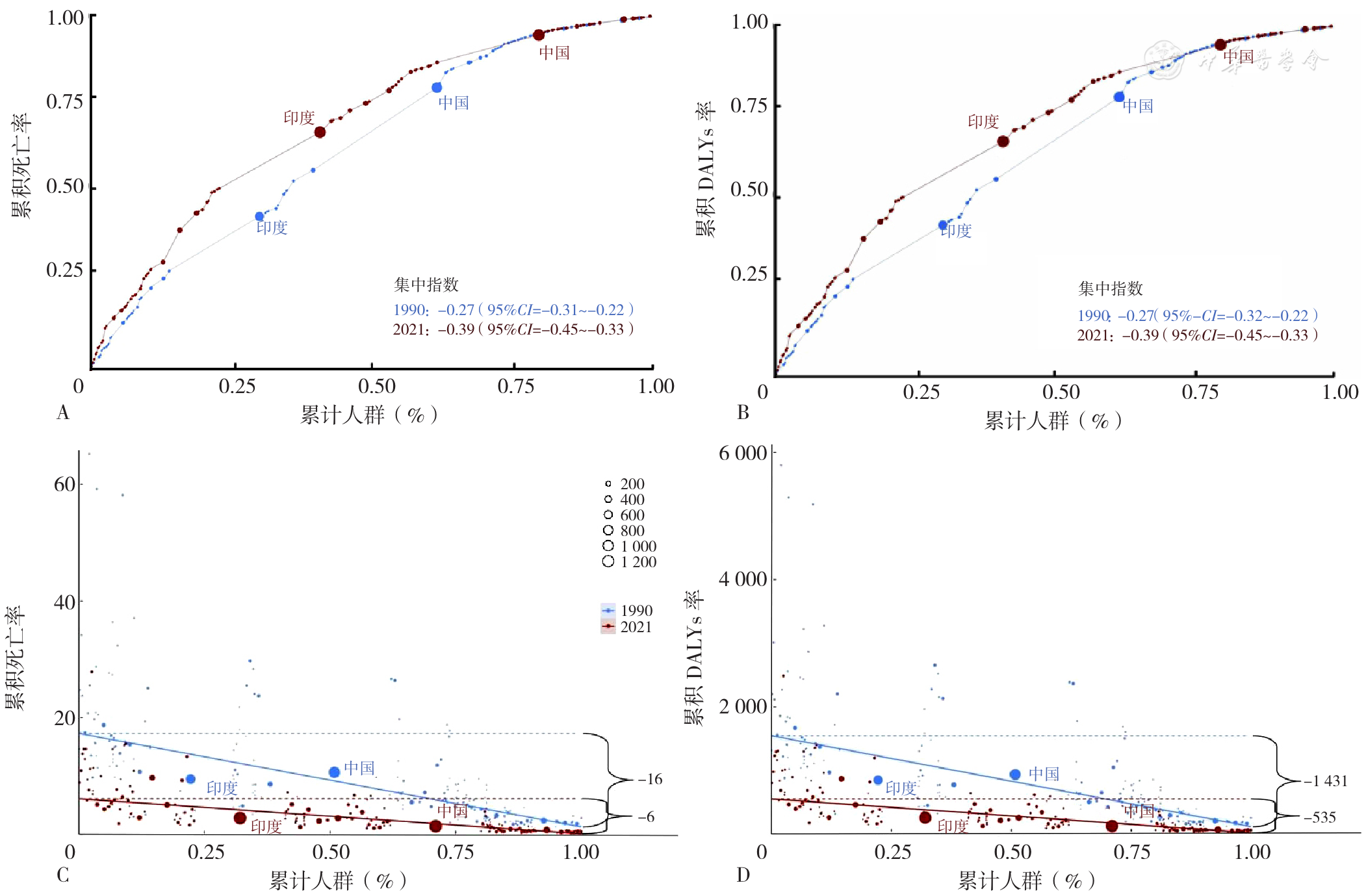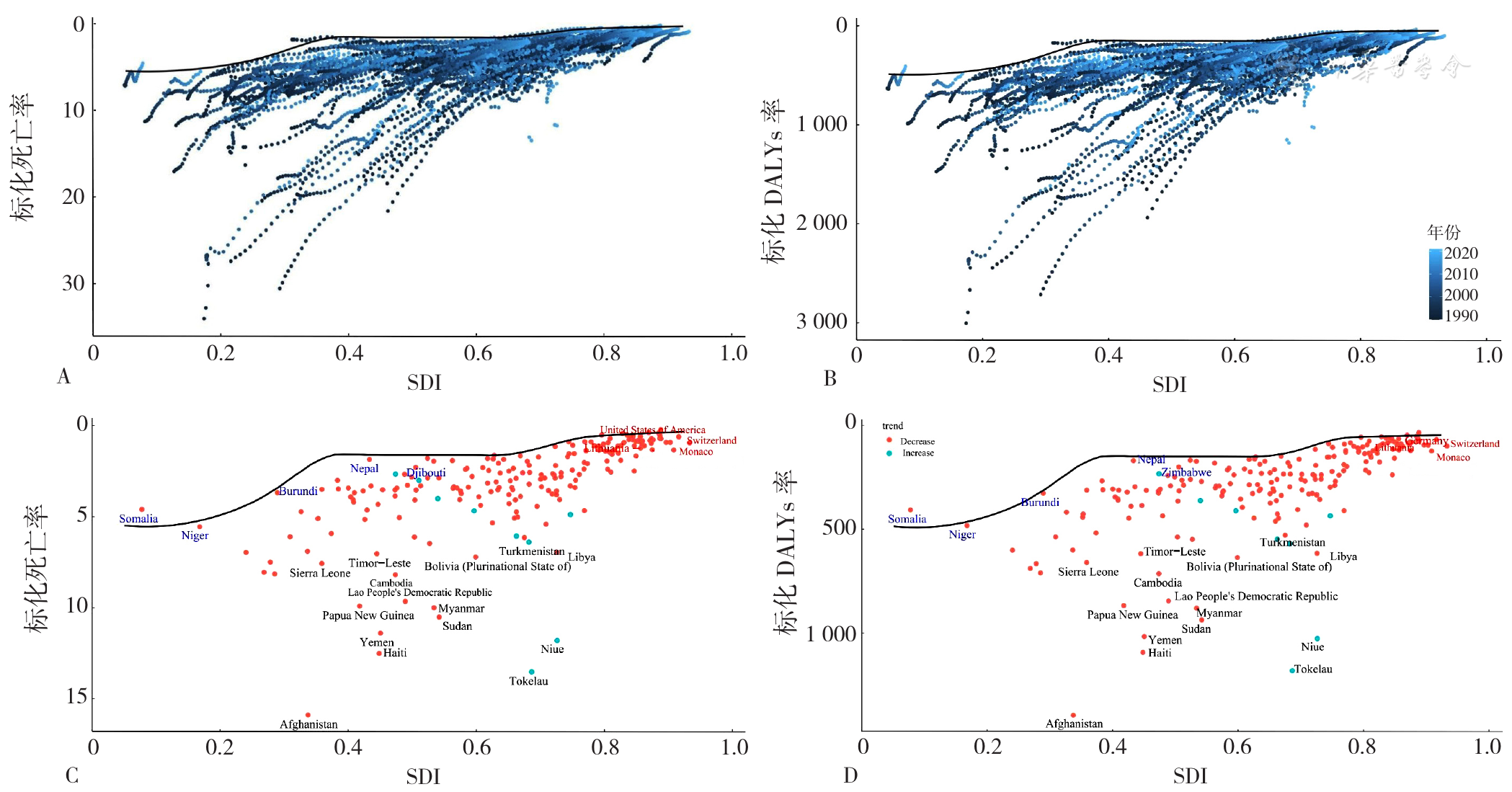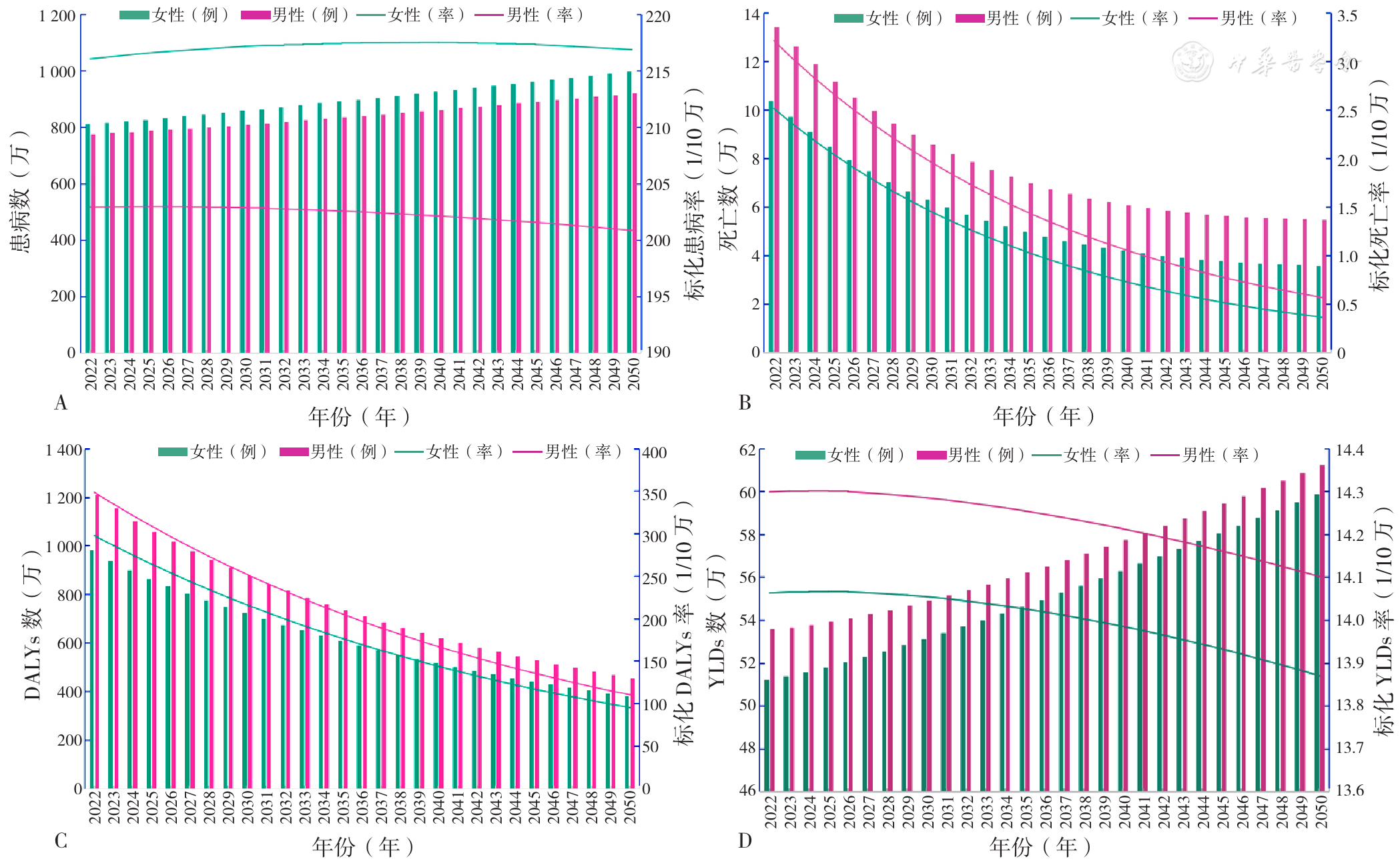中国全科医学 ›› 2025, Vol. 28 ›› Issue (18): 2253-2261.DOI: 10.12114/j.issn.1007-9572.2024.0640
张冰清1, 王忠凯1, 吴长勇1, 孙煌1, 李锐洁1, 刘文洁1, 骆怡哗1, 郑丽慧1, 彭云珠2,*( )
)
收稿日期:2025-01-10
修回日期:2025-02-28
出版日期:2025-06-20
发布日期:2025-04-25
通讯作者:
彭云珠
张冰清与王忠凯为共同第一作者
作者贡献:
张冰清、王忠凯和彭云珠负责研究设计、文章撰写和修改;吴长勇负责数据分析和图片绘制;孙煌和李锐洁负责数据校对和研究设计;刘文洁负责数据的校对;骆怡哗和郑丽慧负责数据的收集与整理;彭云珠负责论文的质量控制并进行最终修订,对论文负责;所有作者已确认论文终稿。
基金资助:
ZHANG Bingqing1, WANG Zhongkai1, WU Changyong1, SUN Huang1, LI Ruijie1, LIU Wenjie1, LUO Yihua1, ZHENG Lihui1, PENG Yunzhu2,*( )
)
Received:2025-01-10
Revised:2025-02-28
Published:2025-06-20
Online:2025-04-25
Contact:
PENG Yunzhu
About author:ZHANG Bingqing and WANG Zhongkai are the co-first authors
摘要: 背景 先天性心脏缺陷是一种常见的先天性畸形,是发达国家和发展中国家5岁以下出生缺陷儿童死亡的主要原因。目前先天性心脏缺陷仍是全球健康的巨大挑战,同时存在明显的地区差异和健康不平等问题,疾病的生命周期管理尚有进步空间,因此需要全面评估先天性心脏缺陷疾病负担以制定针对性的防治策略。 目的 探究1990—2021年先天性心脏缺陷疾病负担变化,并预测至2050年的发展趋势,为制定相关政策和措施提供参考,并有望为实现2030年可持续发展目标提供借鉴。 方法 利用2021年全球疾病负担数据库(GBD 2021),统计和分析全球、21个区域和204个国家先天性心脏缺陷患病、死亡、伤残调整寿命年(DALYs)及伤残损失寿命年(YLDs)的数量和标化率,结合相关性分析、健康不平等分析及前沿分析法进一步综合描述先天性心脏缺陷的疾病负担及变化趋势,并采用贝叶斯年龄-时期-队列模型预测2022—2050年疾病负担情况。 结果 2021年全球先天性心脏缺陷标化患病、死亡、DALYs和YLDs率分别为210.70/10万、3.86/10万、345.24/10万和14.25/10万,1990—2021年其估计的平均年度变化百分比(AAPC)分别为0.02%、-2.53%、-2.48%和0.11%;1990—2021年,低社会人口学指数(SDI)地区的标化死亡、DALYs率最高,而高SDI地区的标化患病、YLDs率最高。SDI与先天性心脏缺陷的标化患病率(ρ=0.45,P<0.001)和标化YLDs率(ρ=0.71,P<0.001)呈正相关。相反,SDI与先天性心脏缺陷的标化死亡率、DALYs率呈负相关(ρ均为-0.54,P值均<0.001)。1990—2021年先天性心脏缺陷的绝对健康不平等有所下降,但相对健康不平等却有所增加;预测到2050年,全球先天性心脏缺陷标化患病、死亡、DALYs、YLDs率将分别达到218.24/10万、0.91/10万、118.48/10万、14.73/10万。 结论 1990—2021年,全球先天性心脏缺陷疾病负担呈下降趋势,并且地区的负担随着SDI的增加而下降。
中图分类号:
| 项目 | 标准化患病率 | 标准化死亡率 | ||||
|---|---|---|---|---|---|---|
| 1990年(1/10万) | 2021年(1/10万) | AAPC(95%CI)(%) | 1990年(1/10万) | 2021年(1/10万) | AAPC(95%CI)(%) | |
| 全球 | 209.53(186.40~231.49) | 210.70(187.92~232.48) | 0.02(0.01~0.02) | 8.51(5.01~10.90) | 3.86(3.19~4.70) | -2.53(-2.56~-2.50) |
| 性别 | ||||||
| 女性 | 214.38(190.76~236.98) | 217.20(193.26~240.16) | 0.04(0.03~0.05) | 7.43(4.16~9.56) | 3.51(2.74~4.29) | -2.41(-2.47~-2.34) |
| 男性 | 204.52(181.66~226.41) | 204.17(181.75~225.77) | -0.01(-0.01~0.00) | 9.51(5.14~13.24) | 4.18(3.31~5.42) | -2.62(-2.65~-2.59) |
| SDI水平 | ||||||
| 高SDI | 250.69(226.85~272.64) | 246.92(222.72~271.28) | -0.04(-0.06~-0.03) | 3.69(3.20~4.00) | 1.05(0.90~1.24) | -3.97(-4.09~-3.84) |
| 高-中SDI | 214.42(191.08~238.22) | 219.08(195.74~242.45) | 0.07(0.03~0.11) | 8.87(6.28~10.91) | 2.25(1.87~2.65) | -4.33(-4.51~-4.14) |
| 中SDI | 198.86(176.11~220.09) | 205.81(183.42~226.82) | 0.11(0.10~0.12) | 8.72(5.55~11.52) | 3.20(2.68~3.87) | -3.19(-3.35~-3.04) |
| 低-中SDI | 191.75(169.02~213.02) | 196.90(174.96~218.65) | 0.09(0.06~0.11) | 9.03(4.90~12.21) | 4.29(3.39~5.34) | -2.41(-2.52~-2.30) |
| 低SDI | 190.00(168.27~212.22) | 194.17(171.51~216.06) | 0.07(0.05~0.08) | 9.80(3.74~14.28) | 5.53(4.02~7.44) | -1.80(-1.90~-1.71) |
| 地区 | ||||||
| 安第斯拉丁美洲 | 198.93(178.84~218.61) | 204.30(184.87~222.81) | 0.08(0.05~0.11) | 9.87(5.42~12.77) | 4.05(3.07~5.19) | -2.83(-3.07~-2.59) |
| 澳大拉西亚 | 184.93(165.37~204.46) | 188.81(168.82~209.44) | 0.07(0.05~0.10) | 2.08(1.93~2.27) | 0.79(0.64~0.96) | -3.08(-3.25~-2.90) |
| 加勒比海 | 201.85(180.58~222.77) | 197.77(177.33~218.64) | -0.07(-0.07~-0.06) | 9.84(7.42~12.17) | 6.72(4.20~11.34) | -1.23(-1.43~-1.03) |
| 中亚 | 294.09(258.24~329.31) | 306.00(271.06~340.42) | 0.12(0.07~0.18) | 4.61(4.02~5.20) | 4.68(3.72~5.74) | 0.03(-0.40~0.45) |
| 欧洲中部 | 209.15(187.38~232.28) | 213.81(191.78~238.39) | 0.07(0.04~0.09) | 5.97(5.14~6.63) | 1.49(1.22~1.74) | -4.37(-4.85~-3.88) |
| 中拉丁美洲 | 230.64(206.85~253.79) | 242.43(218.57~266.16) | 0.17(0.14~0.20) | 5.37(4.76~6.07) | 4.39(3.43~5.54) | -0.68(-0.93~-0.42) |
| 撒哈拉以南非洲中部 | 204.54(181.03~230.38) | 204.18(179.19~228.50) | -0.01(-0.03~0.01) | 7.10(2.34~12.78) | 3.24(2.03~5.27) | -2.49(-2.57~-2.41) |
| 东亚 | 189.43(166.35~210.34) | 195.80(173.55~216.60) | 0.11(0.10~0.11) | 10.98(7.01~15.14) | 2.71(2.15~3.45) | -4.47(-4.72~-4.23) |
| 东欧 | 225.70(201.42~250.65) | 225.83(202.08~251.20) | 0.00(-0.05~0.05) | 5.20(4.64~6.18) | 1.66(1.41~2.01) | -3.67(-3.99~-3.35) |
| 撒哈拉以南非洲东部 | 179.54(157.82~199.64) | 179.61(157.97~199.84) | 0.00(-0.01~0.00) | 7.55(2.29~14.74) | 3.74(2.44~6.63) | -2.22(-2.28~-2.17) |
| 高收入亚太地区 | 317.65(284.45~351.28) | 312.02(280.79~343.60) | -0.07(-0.15~0.02) | 3.86(3.14~4.34) | 0.79(0.62~1.04) | -4.98(-5.35~-4.62) |
| 高收入北美 | 190.11(169.97~211.34) | 189.71(171.02~210.01) | 0.01(-0.01~0.03) | 2.81(2.45~3.05) | 1.10(0.97~1.35) | -2.95(-3.34~-2.55) |
| 北非和中东 | 259.10(230.73~287.41) | 269.42(239.68~297.58) | 0.13(0.12~0.14) | 18.75(8.45~26.55) | 5.99(4.76~7.42) | -3.62(-3.72~-3.52) |
| 大洋洲 | 176.29(155.51~197.29) | 177.71(155.25~199.25) | 0.02(0.01~0.04) | 10.28(4.03~14.99) | 9.00(4.35~13.32) | -0.41(-0.64~-0.19) |
| 南亚 | 179.43(159.06~199.59) | 187.82(167.12~209.07) | 0.15(0.09~0.21) | 7.41(4.67~9.87) | 3.63(2.62~5.02) | -2.32(-2.47~-2.16) |
| 东南亚 | 177.60(156.19~197.24) | 179.93(158.29~199.55) | 0.04(0.03~0.05) | 8.03(4.06~10.80) | 4.09(3.36~5.04) | -2.17(-2.27~-2.08) |
| 南拉丁美洲 | 154.22(137.08~170.19) | 163.27(147.61~180.11) | 0.20(0.17~0.22) | 4.34(3.65~5.07) | 2.47(2.04~3.00) | -1.85(-2.21~-1.49) |
| 撒哈拉以南非洲南部 | 248.57(219.52~280.31) | 254.11(225.18~285.14) | 0.07(0.06~0.07) | 2.68(2.17~3.44) | 2.16(1.46~2.86) | -0.69(-0.89~-0.49) |
| 热带拉丁美洲 | 222.17(199.77~244.37) | 194.90(176.19~213.75) | -0.43(-0.45~-0.40) | 5.26(4.51~6.06) | 3.04(2.47~3.68) | -1.80(-2.03~-1.56) |
| 西欧 | 293.27(266.60~318.48) | 298.44(269.05~326.88) | 0.05(0.00~0.09) | 3.18(2.75~3.44) | 0.89(0.74~1.06) | -4.08(-4.58~-3.57) |
| 撒哈拉以南非洲西部 | 206.51(182.25~231.24) | 207.94(183.93~231.93) | 0.02(0.01~0.04) | 9.22(2.74~13.91) | 5.96(3.80~8.25) | -1.40(-1.52~-1.27) |
| 项目 | 标准化DALYs率 | 标准化YLDs率 | ||||
| 1990年(1/10万) | 2021年(1/10万) | AAPC(95%CI)(%) | 1990年(1/10万) | 2021年(1/10万) | AAPC(95%CI)(%) | |
| 全球 | 750.30(440.94~960.11) | 345.24(288.34~422.16) | -2.48(-2.51~-2.46) | 13.80(7.98~21.28) | 14.25(8.27~21.88) | 0.11(0.09~0.12) |
| 性别 | ||||||
| 女性 | 653.77(361.07~843.73) | 314.77(246.00~381.74) | -2.35(-2.42~-2.29) | 13.52(7.75~20.90) | 14.12(8.10~21.71) | 0.14(0.13~0.15) |
| 男性 | 840.45(452.13~1 165.71) | 373.74(294.98~485.29) | -2.58(-2.61~-2.56) | 14.04(8.19~21.57) | 14.36(8.36~22.01) | 0.07(0.06~0.09) |
| SDI水平 | ||||||
| 高SDI | 326.39(283.76~357.66) | 101.70(87.06~118.34) | -3.70(-3.81~-3.59) | 17.93(10.56~27.08) | 17.88(10.52~27.30) | -0.01(-0.02~0.00) |
| 高-中SDI | 783.96(558.45~962.93) | 204.05(171.77~239.89) | -4.25(-4.42~-4.08) | 14.87(8.72~22.86) | 15.87(9.42~24.02) | 0.20(0.15~0.25) |
| 中SDI | 768.69(487.96~1 009.29) | 286.65(241.63~342.81) | -3.14(-3.29~-2.99) | 13.22(7.61~20.41) | 14.46(8.48~21.98) | 0.29(0.27~0.30) |
| 低-中SDI | 796.79(430.97~1 074.70) | 381.65(302.67~476.97) | -2.38(-2.49~-2.27) | 12.33(7.12~19.05) | 13.12(7.64~20.15) | 0.20(0.18~0.22) |
| 低SDI | 860.62(324.42~1 252.88) | 488.54(349.65~658.02) | -1.78(-1.88~-1.69) | 11.49(6.33~18.14) | 12.13(6.82~18.86) | 0.18(0.16~0.20) |
| 地区 | ||||||
| 安第斯拉丁美洲 | 871.67(478.13~1 128.92) | 360.59(278.13~454.80) | -2.81(-3.06~-2.57) | 14.18(8.20~21.92) | 15.13(8.76~22.92) | 0.21(0.18~0.25) |
| 澳大拉西亚 | 180.95(165.96~199.09) | 75.26(60.82~90.15) | -2.80(-2.95~-2.65) | 14.13(8.33~21.12) | 14.87(8.79~21.95) | 0.17(0.14~0.20) |
| 加勒比海 | 860.63(654.68~1 067.15) | 594.06(374.75~982.65) | -1.19(-1.37~-1.00) | 14.21(8.39~21.59) | 13.30(7.50~20.44) | -0.22(-0.24~-0.20) |
| 中亚 | 417.57(363.70~471.60) | 423.52(336.81~519.76) | 0.03(-0.37~0.42) | 18.34(10.38~28.76) | 19.85(11.07~30.88) | 0.26(0.23~0.28) |
| 欧洲中部 | 535.78(461.97~595.51) | 143.86(120.48~167.77) | -4.06(-4.49~-3.62) | 17.55(10.86~25.70) | 18.51(11.40~27.04) | 0.16(0.12~0.19) |
| 中拉丁美洲 | 476.47(421.91~537.81) | 390.66(308.43~492.21) | -0.67(-0.92~-0.41) | 15.56(9.01~23.98) | 17.45(10.38~26.46) | 0.37(0.34~0.40) |
| 撒哈拉以南非洲中部 | 628.73(203.49~1 126.97) | 288.04(186.10~458.16) | -2.48(-2.56 ~-2.39) | 11.65(5.97~18.62) | 12.33(6.89~19.30) | 0.18(0.16~0.19) |
| 东亚 | 962.04(614.30~1 322.94) | 241.17(191.48~305.04) | -4.37(-4.65~-4.10) | 12.47(7.09~19.59) | 14.41(8.46~21.84) | 0.46(0.44~0.48) |
| 东欧 | 463.92(410.99~551.64) | 150.60(126.77~179.24) | -3.62(-3.94 ~-3.29) | 16.89(10.22~24.78) | 16.64(9.90~24.79) | -0.05(-0.07 ~-0.02) |
| 撒哈拉以南非洲东部 | 668.98(200.64~1 291.08) | 334.69(214.90~585.93) | -2.19(-2.25~-2.14) | 10.84(5.87~17.19) | 11.11(6.11~17.62) | 0.08(0.07~0.09) |
| 高收入亚太地区 | 344.78(279.67~392.25) | 82.88(68.11~103.25) | -4.50(-4.81~-4.19) | 20.16(11.39~31.00) | 20.21(11.44~30.74) | 0.00(-0.05~0.06) |
| 高收入北美 | 243.19(212.07~263.27) | 100.75(88.02~118.62) | -2.77(-2.94~-2.59) | 15.41(9.45~22.69) | 14.99(8.99~22.51) | -0.08(-0.14~-0.02) |
| 北非和中东 | 1670.33(755.19~2 355.80) | 539.99(431.98~661.97) | -3.58(-3.68~-3.48) | 16.83(9.55~25.65) | 17.66(10.15~26.71) | 0.15(0.14~0.16) |
| 大洋洲 | 895.31(342.09~1 311.21) | 786.51(364.80~1 169.36) | -0.42(-0.57~-0.26) | 11.23(6.16~17.69) | 11.18(5.92~17.80) | -0.01(-0.03~0.00) |
| 南亚 | 652.50(414.83~870.95) | 324.04(234.07~448.15) | -2.26(-2.42~-2.11) | 11.82(6.91~18.08) | 12.85(7.58~19.44) | 0.28(0.24~0.31) |
| 东南亚 | 708.51(354.57~951.89) | 364.01(298.07~447.05) | -2.15(-2.24~-2.05) | 11.86(6.77~18.43) | 12.13(6.84~18.83) | 0.07(0.06~0.08) |
| 南拉丁美洲 | 386.08(324.42~452.41) | 224.37(186.05~272.12) | -1.78(-2.14~-1.42) | 11.58(6.85~17.90) | 13.02(7.83~19.48) | 0.40(0.33~0.46) |
| 撒哈拉以南非洲南部 | 239.92(195.26~304.84) | 195.26(135.75~257.04) | -0.66(-0.84~-0.48) | 13.58(7.11~21.79) | 14.49(7.75~22.60) | 0.20(0.18~0.23) |
| 热带拉丁美洲 | 470.57(403.47~544.03) | 275.39(224.81~331.72) | -1.76(-2.00~-1.52) | 14.30(8.08~22.34) | 13.99(8.21~21.15) | -0.07(-0.09~-0.05) |
| 西欧 | 285.35(247.62~308.59) | 90.56(76.37~106.50) | -3.67(-4.09~-3.25) | 19.87(11.53~29.92) | 20.31(11.87~30.97) | 0.06(0.01~0.10) |
| 撒哈拉以南非洲西部 | 802.14(235.79~1 218.58) | 520.37(326.58~724.49) | -1.38(-1.51~-1.26) | 12.29(6.69~19.37) | 12.93(7.16~20.10) | 0.17(0.16~0.17) |
表1 1990—2021年全球、SDI水平和区域水平先天性心脏缺陷疾病的年龄标准化患病率、死亡率、DALYs率、YLDs率
Table 1 Age-standardized rate of prevalence and deaths and DALYs and YLDs of congenital heart defects at global,SDI levels and regional levels,1990-2021
| 项目 | 标准化患病率 | 标准化死亡率 | ||||
|---|---|---|---|---|---|---|
| 1990年(1/10万) | 2021年(1/10万) | AAPC(95%CI)(%) | 1990年(1/10万) | 2021年(1/10万) | AAPC(95%CI)(%) | |
| 全球 | 209.53(186.40~231.49) | 210.70(187.92~232.48) | 0.02(0.01~0.02) | 8.51(5.01~10.90) | 3.86(3.19~4.70) | -2.53(-2.56~-2.50) |
| 性别 | ||||||
| 女性 | 214.38(190.76~236.98) | 217.20(193.26~240.16) | 0.04(0.03~0.05) | 7.43(4.16~9.56) | 3.51(2.74~4.29) | -2.41(-2.47~-2.34) |
| 男性 | 204.52(181.66~226.41) | 204.17(181.75~225.77) | -0.01(-0.01~0.00) | 9.51(5.14~13.24) | 4.18(3.31~5.42) | -2.62(-2.65~-2.59) |
| SDI水平 | ||||||
| 高SDI | 250.69(226.85~272.64) | 246.92(222.72~271.28) | -0.04(-0.06~-0.03) | 3.69(3.20~4.00) | 1.05(0.90~1.24) | -3.97(-4.09~-3.84) |
| 高-中SDI | 214.42(191.08~238.22) | 219.08(195.74~242.45) | 0.07(0.03~0.11) | 8.87(6.28~10.91) | 2.25(1.87~2.65) | -4.33(-4.51~-4.14) |
| 中SDI | 198.86(176.11~220.09) | 205.81(183.42~226.82) | 0.11(0.10~0.12) | 8.72(5.55~11.52) | 3.20(2.68~3.87) | -3.19(-3.35~-3.04) |
| 低-中SDI | 191.75(169.02~213.02) | 196.90(174.96~218.65) | 0.09(0.06~0.11) | 9.03(4.90~12.21) | 4.29(3.39~5.34) | -2.41(-2.52~-2.30) |
| 低SDI | 190.00(168.27~212.22) | 194.17(171.51~216.06) | 0.07(0.05~0.08) | 9.80(3.74~14.28) | 5.53(4.02~7.44) | -1.80(-1.90~-1.71) |
| 地区 | ||||||
| 安第斯拉丁美洲 | 198.93(178.84~218.61) | 204.30(184.87~222.81) | 0.08(0.05~0.11) | 9.87(5.42~12.77) | 4.05(3.07~5.19) | -2.83(-3.07~-2.59) |
| 澳大拉西亚 | 184.93(165.37~204.46) | 188.81(168.82~209.44) | 0.07(0.05~0.10) | 2.08(1.93~2.27) | 0.79(0.64~0.96) | -3.08(-3.25~-2.90) |
| 加勒比海 | 201.85(180.58~222.77) | 197.77(177.33~218.64) | -0.07(-0.07~-0.06) | 9.84(7.42~12.17) | 6.72(4.20~11.34) | -1.23(-1.43~-1.03) |
| 中亚 | 294.09(258.24~329.31) | 306.00(271.06~340.42) | 0.12(0.07~0.18) | 4.61(4.02~5.20) | 4.68(3.72~5.74) | 0.03(-0.40~0.45) |
| 欧洲中部 | 209.15(187.38~232.28) | 213.81(191.78~238.39) | 0.07(0.04~0.09) | 5.97(5.14~6.63) | 1.49(1.22~1.74) | -4.37(-4.85~-3.88) |
| 中拉丁美洲 | 230.64(206.85~253.79) | 242.43(218.57~266.16) | 0.17(0.14~0.20) | 5.37(4.76~6.07) | 4.39(3.43~5.54) | -0.68(-0.93~-0.42) |
| 撒哈拉以南非洲中部 | 204.54(181.03~230.38) | 204.18(179.19~228.50) | -0.01(-0.03~0.01) | 7.10(2.34~12.78) | 3.24(2.03~5.27) | -2.49(-2.57~-2.41) |
| 东亚 | 189.43(166.35~210.34) | 195.80(173.55~216.60) | 0.11(0.10~0.11) | 10.98(7.01~15.14) | 2.71(2.15~3.45) | -4.47(-4.72~-4.23) |
| 东欧 | 225.70(201.42~250.65) | 225.83(202.08~251.20) | 0.00(-0.05~0.05) | 5.20(4.64~6.18) | 1.66(1.41~2.01) | -3.67(-3.99~-3.35) |
| 撒哈拉以南非洲东部 | 179.54(157.82~199.64) | 179.61(157.97~199.84) | 0.00(-0.01~0.00) | 7.55(2.29~14.74) | 3.74(2.44~6.63) | -2.22(-2.28~-2.17) |
| 高收入亚太地区 | 317.65(284.45~351.28) | 312.02(280.79~343.60) | -0.07(-0.15~0.02) | 3.86(3.14~4.34) | 0.79(0.62~1.04) | -4.98(-5.35~-4.62) |
| 高收入北美 | 190.11(169.97~211.34) | 189.71(171.02~210.01) | 0.01(-0.01~0.03) | 2.81(2.45~3.05) | 1.10(0.97~1.35) | -2.95(-3.34~-2.55) |
| 北非和中东 | 259.10(230.73~287.41) | 269.42(239.68~297.58) | 0.13(0.12~0.14) | 18.75(8.45~26.55) | 5.99(4.76~7.42) | -3.62(-3.72~-3.52) |
| 大洋洲 | 176.29(155.51~197.29) | 177.71(155.25~199.25) | 0.02(0.01~0.04) | 10.28(4.03~14.99) | 9.00(4.35~13.32) | -0.41(-0.64~-0.19) |
| 南亚 | 179.43(159.06~199.59) | 187.82(167.12~209.07) | 0.15(0.09~0.21) | 7.41(4.67~9.87) | 3.63(2.62~5.02) | -2.32(-2.47~-2.16) |
| 东南亚 | 177.60(156.19~197.24) | 179.93(158.29~199.55) | 0.04(0.03~0.05) | 8.03(4.06~10.80) | 4.09(3.36~5.04) | -2.17(-2.27~-2.08) |
| 南拉丁美洲 | 154.22(137.08~170.19) | 163.27(147.61~180.11) | 0.20(0.17~0.22) | 4.34(3.65~5.07) | 2.47(2.04~3.00) | -1.85(-2.21~-1.49) |
| 撒哈拉以南非洲南部 | 248.57(219.52~280.31) | 254.11(225.18~285.14) | 0.07(0.06~0.07) | 2.68(2.17~3.44) | 2.16(1.46~2.86) | -0.69(-0.89~-0.49) |
| 热带拉丁美洲 | 222.17(199.77~244.37) | 194.90(176.19~213.75) | -0.43(-0.45~-0.40) | 5.26(4.51~6.06) | 3.04(2.47~3.68) | -1.80(-2.03~-1.56) |
| 西欧 | 293.27(266.60~318.48) | 298.44(269.05~326.88) | 0.05(0.00~0.09) | 3.18(2.75~3.44) | 0.89(0.74~1.06) | -4.08(-4.58~-3.57) |
| 撒哈拉以南非洲西部 | 206.51(182.25~231.24) | 207.94(183.93~231.93) | 0.02(0.01~0.04) | 9.22(2.74~13.91) | 5.96(3.80~8.25) | -1.40(-1.52~-1.27) |
| 项目 | 标准化DALYs率 | 标准化YLDs率 | ||||
| 1990年(1/10万) | 2021年(1/10万) | AAPC(95%CI)(%) | 1990年(1/10万) | 2021年(1/10万) | AAPC(95%CI)(%) | |
| 全球 | 750.30(440.94~960.11) | 345.24(288.34~422.16) | -2.48(-2.51~-2.46) | 13.80(7.98~21.28) | 14.25(8.27~21.88) | 0.11(0.09~0.12) |
| 性别 | ||||||
| 女性 | 653.77(361.07~843.73) | 314.77(246.00~381.74) | -2.35(-2.42~-2.29) | 13.52(7.75~20.90) | 14.12(8.10~21.71) | 0.14(0.13~0.15) |
| 男性 | 840.45(452.13~1 165.71) | 373.74(294.98~485.29) | -2.58(-2.61~-2.56) | 14.04(8.19~21.57) | 14.36(8.36~22.01) | 0.07(0.06~0.09) |
| SDI水平 | ||||||
| 高SDI | 326.39(283.76~357.66) | 101.70(87.06~118.34) | -3.70(-3.81~-3.59) | 17.93(10.56~27.08) | 17.88(10.52~27.30) | -0.01(-0.02~0.00) |
| 高-中SDI | 783.96(558.45~962.93) | 204.05(171.77~239.89) | -4.25(-4.42~-4.08) | 14.87(8.72~22.86) | 15.87(9.42~24.02) | 0.20(0.15~0.25) |
| 中SDI | 768.69(487.96~1 009.29) | 286.65(241.63~342.81) | -3.14(-3.29~-2.99) | 13.22(7.61~20.41) | 14.46(8.48~21.98) | 0.29(0.27~0.30) |
| 低-中SDI | 796.79(430.97~1 074.70) | 381.65(302.67~476.97) | -2.38(-2.49~-2.27) | 12.33(7.12~19.05) | 13.12(7.64~20.15) | 0.20(0.18~0.22) |
| 低SDI | 860.62(324.42~1 252.88) | 488.54(349.65~658.02) | -1.78(-1.88~-1.69) | 11.49(6.33~18.14) | 12.13(6.82~18.86) | 0.18(0.16~0.20) |
| 地区 | ||||||
| 安第斯拉丁美洲 | 871.67(478.13~1 128.92) | 360.59(278.13~454.80) | -2.81(-3.06~-2.57) | 14.18(8.20~21.92) | 15.13(8.76~22.92) | 0.21(0.18~0.25) |
| 澳大拉西亚 | 180.95(165.96~199.09) | 75.26(60.82~90.15) | -2.80(-2.95~-2.65) | 14.13(8.33~21.12) | 14.87(8.79~21.95) | 0.17(0.14~0.20) |
| 加勒比海 | 860.63(654.68~1 067.15) | 594.06(374.75~982.65) | -1.19(-1.37~-1.00) | 14.21(8.39~21.59) | 13.30(7.50~20.44) | -0.22(-0.24~-0.20) |
| 中亚 | 417.57(363.70~471.60) | 423.52(336.81~519.76) | 0.03(-0.37~0.42) | 18.34(10.38~28.76) | 19.85(11.07~30.88) | 0.26(0.23~0.28) |
| 欧洲中部 | 535.78(461.97~595.51) | 143.86(120.48~167.77) | -4.06(-4.49~-3.62) | 17.55(10.86~25.70) | 18.51(11.40~27.04) | 0.16(0.12~0.19) |
| 中拉丁美洲 | 476.47(421.91~537.81) | 390.66(308.43~492.21) | -0.67(-0.92~-0.41) | 15.56(9.01~23.98) | 17.45(10.38~26.46) | 0.37(0.34~0.40) |
| 撒哈拉以南非洲中部 | 628.73(203.49~1 126.97) | 288.04(186.10~458.16) | -2.48(-2.56 ~-2.39) | 11.65(5.97~18.62) | 12.33(6.89~19.30) | 0.18(0.16~0.19) |
| 东亚 | 962.04(614.30~1 322.94) | 241.17(191.48~305.04) | -4.37(-4.65~-4.10) | 12.47(7.09~19.59) | 14.41(8.46~21.84) | 0.46(0.44~0.48) |
| 东欧 | 463.92(410.99~551.64) | 150.60(126.77~179.24) | -3.62(-3.94 ~-3.29) | 16.89(10.22~24.78) | 16.64(9.90~24.79) | -0.05(-0.07 ~-0.02) |
| 撒哈拉以南非洲东部 | 668.98(200.64~1 291.08) | 334.69(214.90~585.93) | -2.19(-2.25~-2.14) | 10.84(5.87~17.19) | 11.11(6.11~17.62) | 0.08(0.07~0.09) |
| 高收入亚太地区 | 344.78(279.67~392.25) | 82.88(68.11~103.25) | -4.50(-4.81~-4.19) | 20.16(11.39~31.00) | 20.21(11.44~30.74) | 0.00(-0.05~0.06) |
| 高收入北美 | 243.19(212.07~263.27) | 100.75(88.02~118.62) | -2.77(-2.94~-2.59) | 15.41(9.45~22.69) | 14.99(8.99~22.51) | -0.08(-0.14~-0.02) |
| 北非和中东 | 1670.33(755.19~2 355.80) | 539.99(431.98~661.97) | -3.58(-3.68~-3.48) | 16.83(9.55~25.65) | 17.66(10.15~26.71) | 0.15(0.14~0.16) |
| 大洋洲 | 895.31(342.09~1 311.21) | 786.51(364.80~1 169.36) | -0.42(-0.57~-0.26) | 11.23(6.16~17.69) | 11.18(5.92~17.80) | -0.01(-0.03~0.00) |
| 南亚 | 652.50(414.83~870.95) | 324.04(234.07~448.15) | -2.26(-2.42~-2.11) | 11.82(6.91~18.08) | 12.85(7.58~19.44) | 0.28(0.24~0.31) |
| 东南亚 | 708.51(354.57~951.89) | 364.01(298.07~447.05) | -2.15(-2.24~-2.05) | 11.86(6.77~18.43) | 12.13(6.84~18.83) | 0.07(0.06~0.08) |
| 南拉丁美洲 | 386.08(324.42~452.41) | 224.37(186.05~272.12) | -1.78(-2.14~-1.42) | 11.58(6.85~17.90) | 13.02(7.83~19.48) | 0.40(0.33~0.46) |
| 撒哈拉以南非洲南部 | 239.92(195.26~304.84) | 195.26(135.75~257.04) | -0.66(-0.84~-0.48) | 13.58(7.11~21.79) | 14.49(7.75~22.60) | 0.20(0.18~0.23) |
| 热带拉丁美洲 | 470.57(403.47~544.03) | 275.39(224.81~331.72) | -1.76(-2.00~-1.52) | 14.30(8.08~22.34) | 13.99(8.21~21.15) | -0.07(-0.09~-0.05) |
| 西欧 | 285.35(247.62~308.59) | 90.56(76.37~106.50) | -3.67(-4.09~-3.25) | 19.87(11.53~29.92) | 20.31(11.87~30.97) | 0.06(0.01~0.10) |
| 撒哈拉以南非洲西部 | 802.14(235.79~1 218.58) | 520.37(326.58~724.49) | -1.38(-1.51~-1.26) | 12.29(6.69~19.37) | 12.93(7.16~20.10) | 0.17(0.16~0.17) |

图1 1990—2021年先天性心脏缺陷标化率与SDI的关系注:A为标化患病率,B为标化死亡率,C为标化伤残调整寿命年(DALYs)率,D为标化伤残损失寿命年(YLDs)率;SDI=社会人口学指数。
Figure 1 Relationship between age-standardised rate of congenital heart defects and SDI,1990-2021

图2 1990年和2021年全球先天性心脏缺陷死亡率和DALYs率的健康不平等回归曲线和集中曲线注:A、B为先天性心脏缺陷死亡率和DALYs率的集中指数,C、D为先天性心脏缺陷死亡率和DALYs率的不平等斜率指数。
Figure 2 Health inequality regression and concentration curves for the mortality and DALYs rate of congenital heart defects in 1990 and 2021

图3 基于1990—2021年204个国家和地区SDI和先天性心脏缺陷标准化率的前沿分析注:A为标化死亡率,B为标化DALYs率,C为标化死亡率,D为标化DALYs率。C和D中点代表国家和地区,边界以纯黑色划定;黑色字体用于标注有效差异最大的前15个国家;红色字体用于标记具有高SDI和相对于其发展水平的较高有效差异的国家和地区;蓝色字体用于标记具有低SDI和低有效差异的前沿国家;橙点表示先天性心脏缺陷标化率从1990—2021年下降;绿点表示先天性心脏缺陷标化率从1990—2021年上升。
Figure 3 Frontier analysis based on the SDI and age-standardised rate of congenital heart defects in 204 countries and regions,1990-2021

图4 2022—2050年全球先天性心脏缺陷疾病负担预测趋势注:A表示患病,B表示死亡,C表示DALYs,D表示YLDs。
Figure 4 Predicted trends in number and age-standardised rate of congenital heart defects at the global level,2022-2050
| [1] |
International SoCIety for Nomenclature of Paediatric and Congenital Heart Disease[EB/OL].(2022-05-22)[2024-11-17].
|
| [2] |
|
| [3] |
|
| [4] |
|
| [5] |
GBD 2019 Under-5 Mortality Collaborators. Global,regional,and national progress towards Sustainable Development Goal 3.2 for neonatal and child health:all-cause and cause-specific mortality findings from the Global Burden of Disease Study 2019[J]. Lancet,2021,398(10303):870-905. DOI:10.1016/S0140-6736(21)01207-1.
|
| [6] |
GBD 2017 Congenital Heart Disease Collaborators. Global,regional,and national burden of congenital heart disease,1990-2017:a systematic analysis for the Global Burden of Disease Study 2017[J]. Lancet Child Adolesc Health,2020,4(3):185-200. DOI:10.1016/S2352-4642(19)30402-X.
|
| [7] |
|
| [8] |
COLLABORATORS G 2 D A I. Global incidence,prevalence,years lived with disability(YLDs),disability-adjusted life-years(DALYs),and healthy life expectancy(HALE)for 371 diseases and injuries in 204 countries and territories and 811 subnational locations,1990-2021:a systematic analysis for the Global Burden of Disease Study 2021[J]. Lancet,2024,403(10440):2133-2161. DOI:10.1016/S0140-6736(24)00757-8.
|
| [9] |
COLLABORATORS G 2 A M. Global,regional,and national mortality among young people aged 10-24 years,1950-2019:a systematic analysis for the Global Burden of Disease Study 2019[J]. Lancet,2021,398(10311):1593-1618. DOI:10.1016/S0140-6736(21)01546-4.
|
| [10] |
廖星雨,田思雨,陈敏. 1990—2021年中国与全球不同性别早发型结直肠癌的疾病负担和危险因素及预测研究[J]. 中国全科医学,2025,28(8):1004-1011.
|
| [11] |
|
| [12] |
|
| [13] |
|
| [14] |
|
| [15] |
|
| [16] |
|
| [17] |
|
| [18] |
|
| [19] |
任佳,李俊利,朱华. 心脏生物标志物在潜伏青紫型先天性心脏病中的研究进展[J]. 内蒙古医学杂志,2022,54(3):292-294. DOI:10.16096/J.cnki.nmgyxzz.2022.54.03.013.
|
| [20] |
|
| [21] |
|
| [22] |
|
| [23] |
|
| [1] | 贾高鹏, 陈秋雨. 老年急性ST段抬高型心肌梗死经皮冠状动脉介入治疗术后心绞痛复发风险预测模型构建和验证:基于CYP2C19相关基因检测[J]. 中国全科医学, 2025, 28(30): 3779-3786. |
| [2] | 徐百川, 王艳, 张彭, 李艺婷, 刘飞来, 谢洋. 慢性阻塞性肺疾病共病肺癌筛查工具分析[J]. 中国全科医学, 2025, 28(30): 3847-3852. |
| [3] | 李玲, 李雅萍, 钱时兴, 聂婧, 陆春华, 李霞. 社区中老年人认知功能影响因素及风险预测研究[J]. 中国全科医学, 2025, 28(30): 3773-3778. |
| [4] | 周晟, 邓长生, 邹冠炀, 宋健平. 疟疾心血管疾病并发症发病机制的研究进展[J]. 中国全科医学, 2025, 28(27): 3466-3472. |
| [5] | 尚忠华, 蒋芝月, 黄朝晖, 杨星, 刘海燕, 张丽. 1990—2021年中国宫颈癌疾病负担趋势分析及2022—2035年预测研究[J]. 中国全科医学, 2025, 28(26): 3314-3320. |
| [6] | 向心月, 张冰青, 欧阳煜钦, 汤文娟, 冯文焕. 短期内科门诊减重对肥胖患者动脉粥样硬化性心血管疾病风险的影响研究[J]. 中国全科医学, 2025, 28(26): 3229-3239. |
| [7] | 刘银银, 隋鸿平, 李婷婷, 姜桐桐, 史铁英, 夏云龙. 乳腺癌治疗相关心脏毒性风险预测模型的研究进展[J]. 中国全科医学, 2025, 28(24): 3072-3078. |
| [8] | 吴莎, 张代义, 李晋, 宣勤考, 钱晓东, 朱传武, 浦剑虹, 朱莉. 基于体检队列的代谢相关脂肪性肝病与高血糖关联及联合预测模型构建研究[J]. 中国全科医学, 2025, 28(23): 2861-2869. |
| [9] | 周倩, 吴晓敏, 王宝华, 严若菡, 蔚苗, 吴静. 胃癌发生风险的列线图预测模型研究[J]. 中国全科医学, 2025, 28(23): 2870-2877. |
| [10] | 赵晓晴, 郭桐桐, 张欣怡, 李林虹, 张亚, 嵇丽红, 董志伟, 高倩倩, 蔡伟芹, 郑文贵, 井淇. 社区老年人认知障碍风险预测模型的构建与验证研究[J]. 中国全科医学, 2025, 28(22): 2776-2783. |
| [11] | 潘姚佳, 傅方琳, 韩正, 孙梦, 顾怀聪, 王为强. 肥胖类型与心血管代谢性共病的关系:基于不同性别的中年居民[J]. 中国全科医学, 2025, 28(18): 2285-2293. |
| [12] | 张志东, 金华, 胡继宏, 蒋露, 王莉, 龙开冲, 张荣华. 1990—2021年中国高血压肾病发病率和死亡率变化趋势分析及预测研究[J]. 中国全科医学, 2025, 28(18): 2262-2269. |
| [13] | 韩正, 孙梦, 傅方琳, 潘姚佳, 王为强. 50岁及以上人群三酰甘油葡萄糖指数与心血管代谢性共病关系的研究[J]. 中国全科医学, 2025, 28(18): 2278-2284. |
| [14] | 方良梅, 苗瑞芬, 王荣, 仇蓓蓓, 洪忻, 王莉娜. 1992—2021年中国耐多药结核病疾病负担变化趋势分析[J]. 中国全科医学, 2025, 28(17): 2163-2171. |
| [15] | 安芹彧, 王艺颖, 张小丹, 张畑霖, 詹清清, 张福艳, 刘涛, 吴延莉. 社会经济地位、健康生活方式对心血管疾病影响的前瞻性队列研究[J]. 中国全科医学, 2025, 28(16): 2017-2024. |
| 阅读次数 | ||||||
|
全文 |
|
|||||
|
摘要 |
|
|||||





